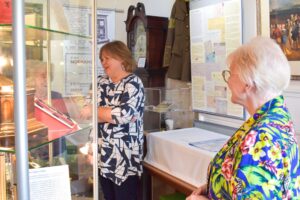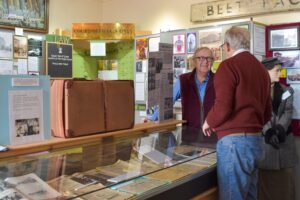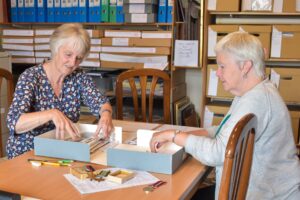Running a Volunteer-Led Museum
Cupar Museum and Heritage Centre first opened its doors in 2012 thanks to the efforts of a network of dedicated volunteers. Over the past ten years, these volunteers have developed a dynamic and proactive approach to museum management, engaging with community groups and expanding their collections to shed new light on the history of their hometown.

The project
The process of establishing a museum in Cupar began in 2009 when local resident Ian Copland discovered that ScotRail was looking to repurpose some unused rooms at Cupar Station. Ian met with ScotRail to outline plans for a museum and was able to secure the space for a nominal annual fee. Ian obtained the support of the Cupar Heritage membership to create a dedicated group of volunteers and build a strong base of support for the project.
Volunteers at Cupar Museum and Heritage Centre are encouraged to take on responsibilities which align with their strengths and interests. Some prefer front-of-house roles, while others focus on collections and cataloguing. Volunteers have also led research and engagement projects exploring Cupar’s family histories, architecture, and industrial heritage. Current research into the former Hawklaw Listening Station near Cupar that was established during WWII is involving volunteers in contact with Bletchley Park, the museum dedicated to Britain’s WWII Codebreakers, and the National Archives at Kew.
The museum has grown into a ‘history hub’ where the people of Cupar can ask questions, investigate stories, and make connections with their community. The museum’s volunteers often advise the community council on matters of local history.
Cupar Museum and Heritage Centre continues to develop as an organisation. The team aims to formalise its volunteering rotas and communicate more regularly with supporters via newsletter.
“It’s really important for us to have a museum in Cupar. If it wasn’t here, the town’s heritage would be lost.”
Ian Copland, Volunteer, Cupar Museum and Heritage Centre

Challenges and successes
- Volunteers found that establishing the museum was a slow and occasionally frustrating experience. Grant applications were made to the Scottish Government and the Railway Heritage Trust, among others, with the latter offering to cover 40% of the museum’s initial funding needs.
- Cupar Museum and Heritage Centre has gained new audiences by contributing to display cases in the local library, conducting walking tours, and organising loans with Cupar’s twin town of Sainte-Menehould in France.
- The museum’s volunteers acknowledge that it can be difficult to engage with the local community. They plan to develop their outreach and engagement by creating loans boxes for schools, care homes, and community groups.
Impact
- There is a strong social element to volunteering at Cupar Museum and Heritage Centre- over the years, the volunteers have developed a friendly and welcoming community.
- Several of the museum’s younger volunteers have gone on secure employment at other museums, while others have gained the skills required to successfully apply for university.
Lessons learned
- The museum team works closely with Cupar Development Trust, community groups, the local press, and CuparNow, the Digital Improvement District team which serves the local area. They have been able to build trust with the community and grow their collections by demonstrating that objects are properly documented and maintained in their care.
- Volunteers at the museum have adopted a proactive approach to community engagement. They acknowledge that there are elements of give-and-take to this relationship, with the museum striving to meet and manage the expectations of local groups.
- The museum team has found it important to acknowledge that younger volunteers are looking for opportunities to build their skills, and that they may not always be part of the team for long.
Guidance
- Before the volunteers secured a space for the museum, collecting and saving items of local interest was ongoing. This activity was supported by regular attendees at the programme of local history talks.
- Cupar Museum and Heritage Centre has recruited volunteers over social media, on their website, and in-person. They recognise museums are spaces where all should feel welcome, and that they should accommodate a broad range of skills, abilities, and availabilities.
- As a small and flexible team, the museum’s volunteers are able to take an enterprising approach to the preservation of local history. Upon learning that records of the Corn Exchange Company were in the custody of a local accountancy firm, these were acquired by purchasing the company from the remaining shareholders for a nominal sum rather than see them lost to posterity. Volunteers also reach out to local groups and businesses to ensure their stories are represented in the museum’s collections.

Useful resources
Contact Cupar Museum and Heritage Centre by email or by calling 01334 844979
Visit the Cupar Museum and Heritage Centre website: cuparheritage.org.uk